
As a distributor in North America for Mexico Porphyry
& Stone in San Luis de La Pais, Mexico, Milestone Imports of Santa
Fe, NM, has witnessed major development in the quarry through the years. Today,
Milestone represents the Mexican quarry in the U.S.
and Canada as well as Japan and Taiwan.
What began as an import of two truckloads of porphyry from Mexico Porphyry & Stone of San Luis de La Pais, Mexico, has grown to become a profitable business for Milestone Imports of Santa Fe, NM. The company, which became involved with the material in the mid-1990s - has experienced a steady increase in its area and beyond through the years. Today, Milestone represents the Mexican quarry in the U.S. and Canada as well as in Asia.
“I’ve traveled to Europe and always loved the stone,” said Miles Chaffee, President of Milestone Imports. “I saw an ad in Stone World by Mexico Porphyry & Stone and called and arranged a trip. I was very fortunate in that the owners, Renzo Stenico and his wife, were there. We toured the quarry, and I ended up buying and importing two truckloads of the stone.
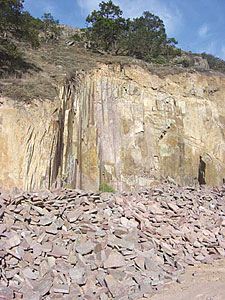
Explosives are used in the quarry process. “This
consists of putting a series of small explosives at the foot of the formation
with a blast causing the flagging to fall from the face above,” said Miles
Chaffee, President of Milestone Imports in Santa Fe, NM.
Discovering the quarry
Chaffee’s first visit to the quarry site in Mexico came in 1994, where he met the Stenico family, which is Italian by heritage. The family had researched the material and found that the San Luis de La Paz, Guanajuato region of Mexico has vast reserves of porphyry. Eventually they acquired a porphyry producing property and they began operating the quarry in 1995.
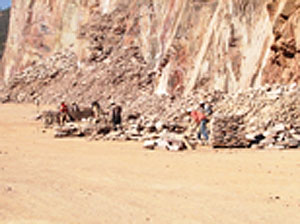
The quarry employs a total of 122 workers, all from
the nearby village. “By hiring 122 [locals], the employees there now have
Mexican social security,” Chaffee said. “Mexico has a universal health care
through its Social Security.”
Used for thousands of years as a paving stone in areas such as Italy, Egypt and France, porphyry is known for its durability and low maintenance. The igneous rock comes from volcanic magma, and as it cools, it forms a material of exceptional hardness.
Due to its hard surface and the minerals it contains - including 70% silica, approximately 14% alumna, 8% alkali and small percentages of iron, calcium and magnesium - porphyry will not become slippery when wet, according to the company, making it an ideal application for paving.
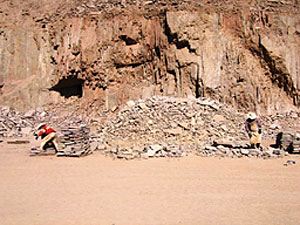
In order to extract material from the quarry site, the process includes the use of explosives. “This consists of putting a series of small explosives at the foot of the formation with a small blast causing the flagging to fall from the face above,” said Chaffee.
“It’s very easy,” added Carlos Gamba, who manages the quarry. “Once it’s down, we separate the sheets, which are in irregular patterns. Those are only cut on splitting machines [on the natural cleave of the material.] It’s completely natural.”
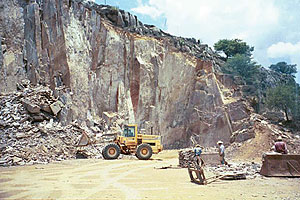
The porphyry is separated with large front-end
loaders, and then the workable part is taken by truck to be sorted more
thoroughly.
The splitting and cutting is done on 14 cutting machines and 20 splitting machines. “The quarry workers then proceed with the sorting of the slabs on the basis of quality, thickness, size and shape,” said Chaffee. “The slabs are then brought to the cutting area to be snap cut or sawn into various widths and lengths. Finally, the cut pavers are put on pallets ready for shipping.”
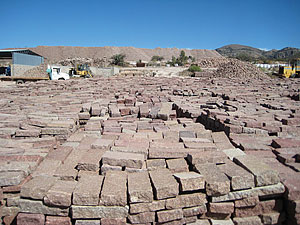
“The larger blocks are split and reduced to dimensions
which can be dealt with by the quarry workers, who can carry out the sorting,”
said Chaffee.
Final applications of the product include residential driveways, patios, roadways and paving for hotels, shopping centers, campuses, ski areas, civic projects, wineries and churches. “It really gives that Old World charm,” said Chaffee. “Residential driveways and urban streets and crosswalks are the dominant use.”
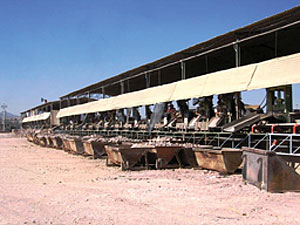
The splitting and cutting is done on 14 Steinex
cutting machines and 20 splitting machines, the majority of which are
manufactured by Zonato.
According to Chaffee, the quarry has been a source of good fortune and opportunity for the surrounding area. “There was literally no electricity where the quarry was,” he said. “The Stenico family brought electricity to the quarry.
“A lot of things that happened really helped the village,” continued Chaffee. “The quarry now employees 122 people, and through the help of the Mexican government, there’s now a clinic that offers prenatal care. A new preschool has been started as well.”
Chaffee went on to explain that a range of improvements to the infrastructure have been implemented around the quarry. “The roads have been improved so trucks can better get in and out,” he said. “It used to be 30 miles of the roughest roads, and that was the only way people could get in and out of the villages for jobs.”
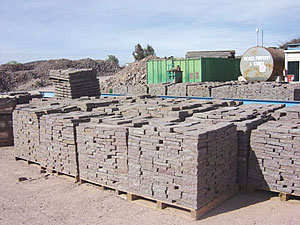
The pieces range from small sizes of approximately 2-
to 4-inch cubes to 12- x 12-inch pavers and very rare pieces up to 36 x 48
inches. The thicknesses vary from ½ to 4 ½ inches. The quarry produces
approximately 180 tons of porphyry per shift, generating around 3,600 tons a
month.
The splitting and cutting is done on 14 Steinex cutting machines and 20 splitting machines, the majority of which are manufactured by Zonato. “It opened a lot of opportunity,” he said. “It provided a secure job for a lot of people. This small village has grown. Since 1995, each year the quarry has kept growing and growing. The main change I’ve seen is more investments and equipment through the years.
Continuing on its successful path, Gamba hopes to get more opportunities in the U.S. this year. “Local markets have grown a lot, but the main thing is to export this material to the U.S. and the rest of the world,” he said. “[Last] year was slow, but those things happen and there’s nothing we can do. We just have to keep working. I have a very good feeling for [this] year.”
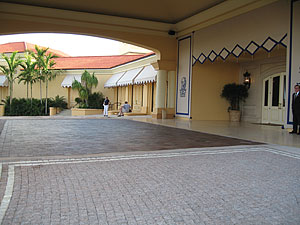
Other popular applications include paving for outdoor
public spaces.
Additional Photos
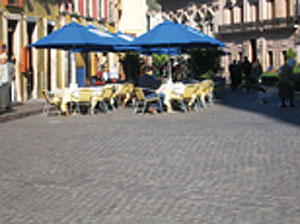
Final applications of the product include commercial
driveways for hotels, including upscale applications such as this Ritz-Carlton
Hotel.